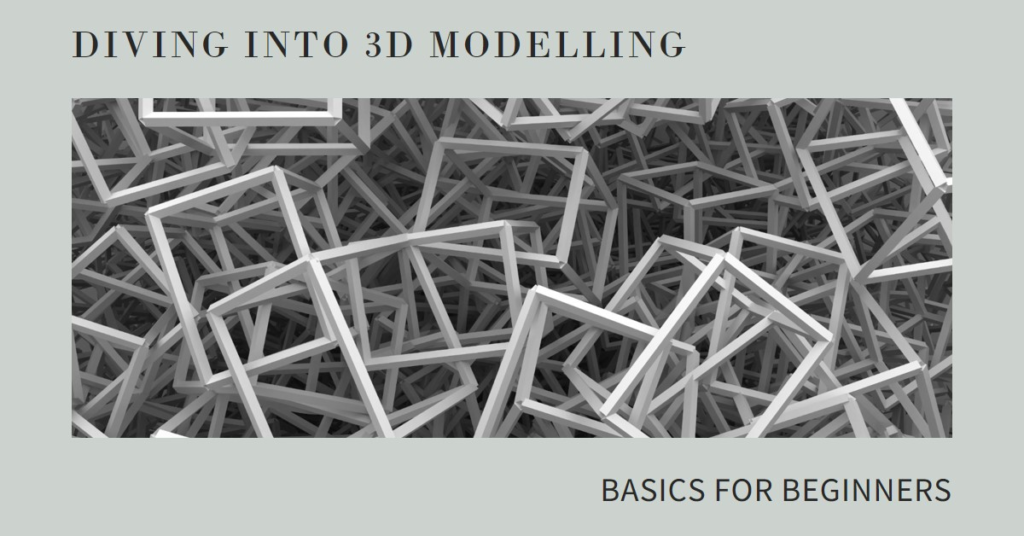
Table of Contents
- Introduction: A Beginner’s Guide
- Understanding 3D Modelling: Foundation and Concepts
- Essential Software Tools for 3D Modelling
- Getting Started: Basic Techniques and Workflow
- Mastering Modelling Techniques: From Meshes to Sculpting
- Texturing and Shading: Bringing Your Models to Life
- Lighting and Rendering: Setting the Stage
- Animation and Rigging: Bringing Motion to Your Models
- Optimization and Best Practices: Enhancing Workflow Efficiency
- Embracing Continuous Learning: Resources and Community Engagement
- Conclusion: Embarking on Your Journey into 3D Modelling
Introduction: A Beginner’s Guide
In today’s digital age, the realm of 3D modelling stands as a captivating gateway into the world of creativity and design. Whether you aspire to create stunning animations, prototype products, or craft immersive environments for games and virtual reality, mastering the fundamentals of 3D modelling is an essential first step. This guide aims to demystify the basics, equipping you with the knowledge and tools needed to embark on your journey into 3D modelling.
Understanding 3D Modelling: Foundation and Concepts
At its core, 3D modelling is the process of creating three-dimensional representations of objects using specialized software. Unlike traditional art forms, which are bound by physical limitations, 3D modelling allows for the creation of complex shapes, textures, and environments that exist purely in the digital realm. This versatility makes it indispensable across industries such as entertainment, architecture, engineering, and more.
To begin your exploration, it’s crucial to grasp some foundational concepts. 3D modelling revolves around three primary elements: vertices, edges, and faces. These elements form the building blocks of digital objects, akin to the way atoms combine to form molecules in the physical world. Vertices represent points in space, edges connect these points to form lines, and faces enclose these lines to create surfaces. By manipulating these elements, modellers can sculpt intricate forms and structures with precision.
Essential Software Tools for 3D Modelling
Before diving into the practical aspects of modelling, selecting the right software is paramount. Industry-standard tools like Autodesk Maya, Blender, and Cinema 4D offer robust features tailored to different skill levels and project requirements. For beginners, Blender stands out as an excellent starting point due to its open-source nature and extensive community support. It provides a comprehensive suite of modelling, animation, and rendering tools without the barrier of cost, making it accessible to aspiring artists and designers worldwide.
Transitioning from traditional art forms to digital modelling can be daunting initially, but these software packages streamline the process with intuitive interfaces and extensive documentation. They empower users to visualize their creations in real-time, experiment with textures and lighting, and refine details with unprecedented control. Moreover, many platforms offer built-in tutorials and online resources to aid beginners in mastering the fundamentals, ensuring a smooth learning curve.
Getting Started: Basic Techniques and Workflow
With software in hand, mastering basic techniques forms the cornerstone of your journey into 3D modelling. Begin by acquainting yourself with navigation controls, which allow you to manipulate and navigate the virtual workspace with ease. Understanding how to zoom, pan, and rotate your view ensures fluid interaction with your models, facilitating precise adjustments and inspections from every angle.
Next, familiarize yourself with primitive shapes such as spheres, cubes, and cylinders. These basic forms serve as the building blocks for more complex designs, enabling you to construct and prototype ideas swiftly. By manipulating these primitives through scaling, rotating, and translating, you gain insights into spatial relationships and proportions—an essential skill in achieving realistic and aesthetically pleasing results.
Mastering Modelling Techniques: From Meshes to Sculpting
As your proficiency grows, delving deeper into modelling techniques expands your creative repertoire. Mesh modelling, the process of manipulating polygonal meshes, lies at the heart of 3D modelling. This technique involves extruding, beveling, and subdividing polygons to refine shapes and add intricate details. By mastering these operations, you gain control over surface topology, ensuring smooth transitions and precise geometries in your models.
For organic shapes and intricate textures, sculpting offers a dynamic approach. Unlike traditional mesh modelling, sculpting tools simulate the tactile sensation of shaping clay, allowing for intuitive and organic forms. Whether crafting character models or natural landscapes, sculpting empowers artists to imbue their creations with lifelike detail and expressive qualities. Popular sculpting tools like ZBrush and Blender’s Sculpt Mode provide a wide array of brushes and dynamic topology features, enabling artists to sculpt with unprecedented fidelity and responsiveness.
Texturing and Shading: Bringing Your Models to Life
While mastering the art of shaping 3D models is essential, texturing and shading elevate your creations to new heights of realism and visual appeal. Textures act as digital skins, applying surface detail such as colors, patterns, and material properties to your models. By employing UV mapping techniques, artists can unwrap 3D surfaces into 2D spaces, facilitating precise texture placement and alignment. This process ensures that textures conform seamlessly to your model’s geometry, enhancing visual fidelity and realism.
Shading, on the other hand, governs how light interacts with your model’s surfaces. Through shader nodes and material editors, artists can simulate a wide range of materials—from glossy plastics to matte metals and translucent glass. By adjusting parameters such as roughness, specular intensity, and ambient occlusion, you can achieve nuanced lighting effects that breathe life into your virtual creations. Additionally, procedural textures and texture painting tools offer versatile means to generate complex patterns and surface variations directly within your modelling environment.
Lighting and Rendering: Setting the Stage
Effective lighting serves as the cornerstone of visual storytelling in 3D modelling, influencing mood, atmosphere, and focal points within your scenes. By strategically placing light sources and adjusting their properties, you can evoke emotions, highlight key features, and guide viewers’ attention within your compositions. Techniques such as global illumination and HDR lighting simulate realistic light behavior, casting dynamic shadows and reflections that enhance depth and realism in your renders.
Rendering transforms your 3D models from wireframes into photorealistic images or animations. It involves the process of calculating how light interacts with surfaces and materials, producing final images with accurate lighting and shading effects. Rendering engines like Cycles in Blender or Arnold in Maya offer advanced features such as ray tracing and path tracing, enabling artists to achieve cinematic quality renders that rival those seen in movies and advertisements. Through iterative refinement and experimentation with render settings, you can fine-tune every aspect of your scene to achieve desired visual outcomes.


Animation and Rigging: Bringing Motion to Your Models
Beyond static imagery, animation breathes life into your 3D creations, enabling them to move, interact, and convey narratives. Animation involves sequencing poses and movements over time, animating characters, objects, and environments with fluidity and believability. Rigging serves as the backbone of animation, defining how 3D models deform and move in response to animator controls or predefined actions.
Rigging entails setting up skeletal structures, known as armatures, within your models. These armatures consist of interconnected bones and joints that simulate anatomical movement and articulation. By assigning vertices to these bones and defining constraints, riggers establish a hierarchy of control, allowing animators to pose characters and objects realistically. Advanced rigging techniques include inverse kinematics (IK) and spline-based deformations, which streamline complex animations such as walking cycles, facial expressions, and dynamic simulations.
Optimization and Best Practices: Enhancing Workflow Efficiency
As your proficiency in 3D modelling grows, optimizing your workflow becomes paramount to maintaining productivity and achieving consistent results. Adopting best practices such as non-destructive editing and modular design facilitates iterative refinement and experimentation without compromising your original models. Techniques like instancing and asset reuse minimize redundancy by replicating objects and components throughout your scenes, reducing file sizes and rendering times while maintaining visual coherence.
Furthermore, familiarizing yourself with render optimization techniques enhances performance without sacrificing quality. This includes adjusting render settings, managing texture resolutions, and leveraging GPU-accelerated rendering solutions for expedited workflow. By implementing efficient UV unwrapping and texture baking workflows, you can streamline texture application and enhance real-time performance in interactive applications and game engines.
Embracing Continuous Learning: Resources and Community Engagement
In the dynamic realm of 3D modelling, continuous learning is key to staying abreast of industry trends, emerging technologies, and artistic innovations. Engaging with online communities, forums, and social media platforms connects you with like-minded artists and industry professionals, fostering collaboration, feedback, and inspiration. Platforms such as ArtStation, Polycount, and Blender Artists offer avenues to showcase your work, seek critique, and discover new techniques from peers and mentors alike.
Additionally, attending workshops, webinars, and industry conferences provides firsthand insights into cutting-edge tools and workflows. Many software developers offer certification programs and educational resources tailored to aspiring artists, validating your skills and expanding your professional network. By cultivating a growth mindset and embracing experimentation, you can push the boundaries of your creativity and evolve as a proficient 3D modeller in a competitive global landscape.
Conclusion: Embarking on Your Journey into 3D Modelling
In conclusion, delving into the fundamentals of 3D modelling opens a world of boundless creativity and innovation. By mastering essential techniques, selecting appropriate software tools, and embracing continuous learning, you lay a solid foundation for realizing your artistic visions and professional aspirations. Whether you aspire to craft captivating animations, design virtual worlds, or prototype revolutionary products, the journey begins with a single vertex and unfolds through dedication, exploration, and a passion for pushing creative boundaries.
As you embark on this transformative journey, remember that proficiency in 3D modelling is not solely measured by technical skill, but by your ability to convey narratives, evoke emotions, and inspire audiences through your digital creations. Embrace challenges as opportunities for growth, celebrate milestones along the way, and forge connections within the vibrant community of 3D artists worldwide. With persistence, curiosity, and a commitment to excellence, your journey into 3D modelling promises to be as rewarding as it is exhilarating.



